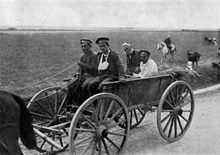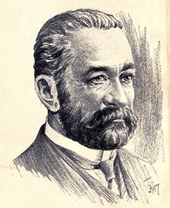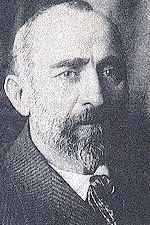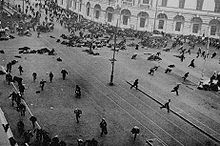February Revolution - Picture
More about World War 1

|
|
February Revolution
Date
March 8-12, 1917
Location
Petrograd, Russia
Result
Abdication of monarchy in Russia, creation of Russian Provisional Government, beginning of dual power (dvoevlastie) between it and the Soviets
Date: March 8-12, 1917
Location: Petrograd, Russia
Result: Abdication of monarchy in Russia, creation of Russian Provisional Government, beginning of dual power (dvoevlastie) between it and the Soviets
Belligerents:
: Russian Empire
Commanders and leaders:
: Nicholas II of Russia
The February Revolution (Russian: Π€Π΅Π²ΡΠ°Π»ΡΡΠΊΠ°Ρ ΡΠ΅Π²ΠΎΠ»ΡΡΠΈΡ) of 1917 was the first of two revolutions in Russia in 1917. Centered around the then capital Petrograd (modern day St. Petersburg) in March (late February in the Julian calendar). Its immediate result was the abdication of Tsar Nicholas II, the end of the Romanov dynasty, and the end of the Russian Empire. The Tsar was replaced by a Russian Provisional Government under Prince Georgy Lvov. The Provisional Government was an alliance between liberals and socialists who wanted political reform. They set up a democratically-elected executive and constituent assembly. At the same time, socialists also formed the Petrograd Soviet, which ruled alongside the Provisional Government, an arrangement termed Dual Power.
This revolution appeared to break out spontaneously, without any real leadership or formal planning. Russia had been suffering from a number of economic and social problems, which were compounded by the impact of World War I. Bread rioters and industrial strikers were joined on the streets by disaffected soldiers from the city's garrison. As more and more troops deserted, and with loyal troops away at the Front, the city fell into a state of anarchy, leading to the overthrow of the Tsar.
The February Revolution was followed in the same year by the October Revolution, bringing Bolshevik rule and a change in Russia's social structure, and paving the way for the USSR. The two revolutions constituted a change in the composition of the country: the first overthrew the Tsar, and the second instituted the Soviet regime: a new form of government.
Causes
A number of factors contributed to the downfall of the Tsarist regime in the spring of 1917, both short and longer term. Different historians apply different weights to each: liberal historians would emphasise the turmoil created by the war, whereas other writers, particularly those influenced by the Materialist conception of history would place their emphasis on the inevitability of change.
Long-term causes
Despite its occurrence at the height of World War I, the roots of the February Revolution traced much further back in time. Chief among these was Imperial Russia's failure, throughout the 19th and early 20th century, to modernize its archaic social, economic and political structures whilst maintaining the stability of ubiquitous devotion to an autocratic monarch. As historian Richard Pipes writes, "the incompatibility of capitalism and autocracy struck all who gave thought to the matter".
The first major event of the Russian Revolution was the February Revolution, which was a chaotic affair and the culmination of over a century of civil and military unrest. The causes of this unrest of the common people towards the Tsar and aristocratic landowners are too many and complicated to neatly summarise, but key factors to consider were ongoing resentment at the cruel treatment of peasants by patricians, poor working conditions experienced by city workers in the fledgling industrial economy and a growing sense of political and social awareness of the lower orders in general (democratic ideas were reaching Russia from the West and being touted by political activists). Dissatisfaction of the proletarian lot was further compounded by food shortages and military failures. In 1905 Russia experienced humiliating losses in the Russo-Japanese war and, during a demonstration against the war in the same year, Tsarist troops fired upon an unarmed crowd - further dividing Nicholas II from his people. Widespread strikes, riots and the famous mutiny on the Battleship Potemkin ensued.
From these conditions sprang considerable agitation among the small working and professional classes. This tension had erupted into general revolt with the 1905 Revolution, and did so again under the strain of total war in 1917.
Short-term causes

Picture - Wounded Russian soldiers retreating from the front
The revolution was provoked not only by Russian military failures during the First World War, but also by public dissatisfaction with the way the country was being run on the Home Front by Tsarina Alexandra Fyodorovna of Hesse and Tsar Nicholas's ministers, and the economic challenges Russia faced fighting a total war.
In August 1914, all classes supported and virtually all political deputies voted in favour of the war (despite calls from "defeatists", including Lenin of the Bolshevik party, that it was not a war worth fighting). The declaration of war was accompanied by a wave of jingoism and flag-waving, which served to effect a temporary moratorium on internal strife. After a few initial victories, such as in Galicia in 1915 and with the Brusilov offensive in 1916, the Tsar's armies were confronted with a number of very serious defeats. Nearly six million casualties had been accrued by January 1917. Mutinies sprang up more often (most due to simple war weariness), morale was at its lowest, and the (newly called up) officers and commanders were at times very incompetent. Like all of the major armies, Russia's armed forces suffered from inadequate supply. The pre-revolution desertion rate ran at around 34,000 a month. Meanwhile, the wartime alliance of industry, Duma and Stavka (Military High Command) started to work outside of the Tsar's control.
In an attempt to boost morale and to repair his own reputation for being weak, Nicholas announced in the summer of 1915 that he would become the new Commander-in-Chief of the army, in defiance of almost universal advice to the contrary. The result was disastrous on three grounds: firstly, it associated the monarchy with the unpopular war; secondly, Nicholas proved a poor leader of men on the front line, often irritating his own commanders with his interference; and thirdly, whilst at the front, he was unavailable to govern. This left the reins of power to his wife, the German Tsarina Alexandra, who was unpopular and accused of being a spy and under the thumb of her confidant Rasputin, himself so unpopular so that he was assassinated by the nobility in December 1916. The very assassination drove another wedge between monarchy and country over whether or not his death required grieving or celebration. Regardless, the Tsarina proved an ineffective ruler in a time of war, announcing a rapid succession of different Prime Ministers and angering the Duma. The lack of strong leadership is illustrated by a telegram from Octobrist politician Mikhail Rodzianko to the Tsar on March 11 [O.S. February 26] 1917, in which Rodzianko begged for a minister with the "confidence of the country" be instated immediately. Delay, he wrote, would be "tantamount to death".
On the home front, a famine was looming and commodities were becoming scarce as a result of problems with the overstretched railroad network. Meanwhile, refugees from German-occupied Russia came in their millions. The Russian economy, which had just seen one of the highest growth rates in Europe, was blocked from the continent's markets by the war. Though industry did not collapse, it was put under considerable strain and when inflation soared, wages could not keep up. The Duma (lower house of parliament), composed of liberal deputies, warned Tsar Nicholas II of the impending danger and counselled him to form a new constitutional government, like that he had dissolved after some short-term attempts in the aftermath of the 1905 Revolution. The Tsar ignored the Duma's advice. Historian Edward Acton argues that "by stubbornly refusing to reach any modus vivendi with the Progressive Bloc of the Duma... Nicholas undermined the loyalty of even those closest to the throne [and] opened an unbridgeable breach between himself and public opinion." In short, the Tsar no longer had the support of the military, the nobility or the Duma (collectively the ιlites), at the same time as the legitimacy of the monarchy with the Russian people was at a low ebb. The result was revolution.
Events
Protests
At the beginning of February, Petrograd workers began several strikes and demonstrations. On March 7 [O.S. February 22], workers at Putilov, Petrograd's largest industrial plant, announced a strike. Although some clashes with the Tsar's forces did occur, no one was injured on the opening day. The strikers were fired, and some shops closed, resulting in further unrest at other plants.
The next day, a series of meetings and rallies were held for International Women's Day, which gradually turned into economic and political gatherings. Demonstrations were organised to demand bread, and these were supported by the industrial working force who considered them a reason for continuing the strikes. The women workers marched to nearby factories bringing out over 50,000 workers on strike. By March 10 [O.S. February 25], virtually every industrial enterprise in Petrograd had been shut down, together with many commercial and service enterprises. Students, white-collar workers and teachers joined the workers in the streets and at public meetings. In the streets, red banners appeared and the crowds chanted "Down with the German woman! Down with Protopopov! Down with the war!"
To quell the riots, the Tsar looked to the army. At least 180,000 troops were available in the capital, but most were either untrained or injured. Historian Ian Beckett suggests around 12,000 could be regarded as reliable, but even these proved reluctant to move in on the crowd, since it included so many women. It was for this reason that when, on March 11 [O.S. February 26], the Tsar ordered the army to suppress the rioting by force, troops began to mutiny.
Tsar's return and abdication
The Tsar had returned to his frontline base at Stavka on March 7 [O.S. February 22]. After violence erupted, however, Mikhail Rodzianko, Chairman of the Duma, sent the Tsar a report of the chaos in a telegram (exact wordings and translations differ, but each retains a similar sense):
The situation is serious. The capital is in a state of anarchy. The Government is paralyzed. Transport service and the supply of food and fuel have become completely disrupted. General discontent is growing... There must be no delay. Any procrastination is tantamount to death. -Rodzianko's first telegram to the Tsar, March 11 [O.S. February 26] 1917.
Nicholas' response, however, on March 12 [O.S. February 27], was one of irritation that "again, this fat Rodzianko has written me lots of nonsense, to which I shall not even deign to reply." Meanwhile, events were unfolding in Petrograd. The bulk of the garrison mutinied, starting with the Volynsky Life Guards regiment. Although few actively joined the rioting, many officers were either shot or went into hiding; the ability of the garrison to hold back the protests was all but nullified, symbols of the Tsarist regime were rapidly torn down around the city and governmental authority in the capital collapsed - not helped by the fact that Nicholas had prorogued the Duma that morning, leaving it with no legal authority to act. The response of the Duma, urged on by the liberal bloc, was to establish a Temporary Committee to restore law and order; meanwhile, the socialist parties establish the Petrograd Soviet to represent workers and soldiers. The remaining loyal units switched allegiance the next day.
The Tsar took a train back towards Petrograd, which was stopped on March 14 [O.S. March 1], having been instructed to divert by a group of disloyal troops. When the Tsar finally reached his destination, the Army Chiefs and his remaining ministers (those who had not fled under pretense of a power-cut) suggested in unison that he abdicate the throne. He did so on March 15 [O.S. March 2], on behalf of himself, and then, having taken advice, on behalf of his son, the Tsarevich. Nicholas nominated his brother, the Grand Duke Michael Alexandrovich, to succeed him. But the Grand Duke realised that he would have little support as ruler, so he declined the crown on March 16 [O.S. March 3], stating that he would take it only if that was the consensus of democratic action by the Russian Constituent Assembly, which shall define form of government for Russia. Six days later, Nicholas, no longer Tsar and addressed with contempt by the sentries as "Nicholas Romanov", was reunited with his family at the Alexander Palace at Tsarskoe Selo. He was placed under house arrest with his family by the Provisional Government.
Provisional Government and Petrograd Soviet share power

Picture - Prince Georgy Lvov, first head of the Provisional Government
The immediate effect of the February Revolution was a widespread atmosphere of elation and excitement in Petrograd. On 16 March [O.S. 3 March], a provisional government was announced. The center-left was well represented, and the government was initially chaired by a liberal aristocrat, Prince Georgy Yevgenyevich Lvov, a member of the Constitutional Democratic party (KD). The socialists had formed their rival body, the Petrograd Soviet (or workers' council) four days earlier. The Petrograd Soviet and the Provisional Government competed for power over Russia.

Picture - Nikolay Chkzheidze, first Chairman of the Executive Committee of the Petrograd Soviet
Between February and April, the Provisional Government, which replaced the Tsar, cooperated successfully with the Petrograd Soviet. This was facilitated by the positive spirit throughout the capital, along with considerable cross-over membership between the two bodies. A general consensus to prevent anarchy also prompted a constructive relationship. This arrangement became known as the "Dual Authority" or "Dual Power". However, the de facto supremacy of the Petrograd Soviet was asserted as early as March 1 (before the creation of the Provisional Government itself), when the Petrograd Soviet issued Order No. 1:
The orders of the Military Commission of the State Duma [part of the organisation which became the Provisional Government] shall be executed only in such cases as do not conflict with the orders and resolution of the Soviet of Workers' and Soldiers' Deputies. -Point 4 of Order No. 1, March 1, 1917.
Order No. 1 thus ensured that the Dual Authority developed on the Soviet's conditions. As the Provisional Government was not a publicly elected body (having been self-proclaimed by committee members of the old Duma), it lacked the political legitimacy to question this arrangement and instead arranged for elections in be held later.
Aftermath
Vladimir Lenin, exiled in neutral Switzerland, arrived in Petrograd from ZxΌrich on 3 April 1917 O.S. He immediately began to undermine the provisional government, issuing his April Theses the next month. These theses were in favour of "revolutionary defeatism", as opposed to the "imperialist war" (whose "link to Capital" must be demonstrated to the masses) and the Social-Chauvinists (such as Georgi Plekhanov the grandfather of Russian socialism), who supported the war. Lenin also took control of the Bolshevik movement and stirred up the proletariat against the government with simple but meaningful slogans such as "Peace, bread and land", "End the war", "All power to the Soviets" and "All land to the peasants". Finally, he announced the necessary creation of a new International to replace the defunct Second International, dissolved in 1916 after the 1915 Zimmerwald Conference.

Picture - A scene from the July Days. The army has just opened fire on street protesters.
Initially, neither Lenin nor his ideas had widespread support, even among Bolsheviks. In what became known as the July Days, approximately half a million came out onto the streets of Petrograd in protest, including soldiers and sailors; Lenin proved incapable of directing them into an organised coup. The demonstrators, lacking leadership, disbanded and the government survived. The Provisional Government saw it as a Bolshevik coup nonetheless and issued arrest warrants for prominent Bolsheviks. Lenin fled to Finland and other members of the Bolshevik party were arrested. Lvov was replaced by the Socialist Revolutionary minister Alexander Kerensky as head of the government.
Kerensky declared freedom of speech, released thousands of political prisoners and did his best to maintain Russian involvement in World War I, but he faced numerous challenges, most of them related to the war: there were some very heavy military losses still being experienced out on the front; dissatisfied soldiers were deserting in larger numbers than before (although, when they got back home, they were generally either imprisoned or sent to the front once more); other political groups were doing their utmost to undermine him; there was a strong movement in favour of stopping Russia's involvement in the war, which was seen to be draining the country, and many who had initially supported it now wanted out; there was a great shortage of food and supplies, which was very difficult to remedy in wartime conditions. All of these were highlighted by the soldiers, urban workers and peasants, who claimed that little had been gained by the February Revolution. Kerensky was expected to deliver on his promises of jobs, land, and food almost instantaneously, and he had failed to do so.
Another issue for Kerensky, the Kornilov Affair, arose when Commander-in-Chief of the army, General Lavr Kornilov, directed an army under Aleksandr Krymov to march toward Petrograd with Kerenky's agreement. Although the details remain sketchy, Kerensky appeared to become frightened by the possibility of a coup and the order was countermanded (historian Richard Pipes is quite adamant that the whole episode was engineered by Kerensky himself). On 27 August, feeling betrayed by the Kerenksy government who had previously agreed with his views on how to restore order to Russia, Kornilov pushed on towards Petrograd. With few troops to spare on the front, Kerensky was forced to turn to the Petrograd Soviet for help. Bolsheviks, Mensheviks and Socialist Revolutionaries confronted the army and convinced them to stand down. The damage was already done, however. Right-wingers felt betrayed, and the left wing was resurgent. Pressure from the Allies to continue the war against Germany put the government under increasing strain. The conflict between the "diarchy" became obvious, and, ultimately, the regime and the dual power formed between the Petrograd Soviet and the Provisional Government instigated by the February Revolution was replaced in the October Revolution.
Russian Revolution of 1917
1905 Russian Revolution
World War I
Vladimir Lenin
Edward Acton (1990). Rethinking the Russian Revolution. Oxford University Press US. ISBN 9780713165302. http://books.google.com/books?id=FLjQ2-BhdPcC. Retrieved 29 August 2010.
Beckett, Ian F.W. (2007). The Great war (2 ed.). Longman. ISBN 1405812524. http://books.google.com/books?id=CMYbKgcAW88C.
Robert Paul Browder; Aleksandr Fyodorovich Kerensky (June 1961). The Russian Provisional Government, 1917: documents. Stanford University Press. ISBN 9780804700238. http://books.google.com/books?id=LzWsAAAAIAAJ. Retrieved 30 August 2010.
Sheila Fitzpatrick (15 April 2008). The Russian Revolution. Oxford University Press US. ISBN 9780199237678. http://books.google.com/books?id=v0-1p3thZyMC. Retrieved 30 August 2010.
Malone, Richard (2004). Analysing the Russian Revolution. Australia: Cambridge University Press. pp. 67. ISBN 0-521-54141-7.
Richard Pipes (27 May 1997). Three "whys" of the Russian Revolution. Vintage Books. ISBN 9780679776468. http://books.google.com/books?id=mdqtQgAACAAJ. Retrieved 8 September 2010.
Richard Pipes (26 June 2008). A Concise History of the Russian Revolution. Paw Prints. ISBN 9781439506806. http://books.google.com/books?id=Ft8dOwAACAAJ. Retrieved 29 August 2010.
Robert Service (2005). A history of modern Russia from Nicholas II to Vladimir Putin. Harvard University Press. ISBN 9780674018013. http://books.google.com/books?id=eseDgCQK9UkC. Retrieved 1 September 2010.
Tames, Richard (1972). Last of the Tsars. London: Pan Books Ltd. ISBN 9780330029025.
Rex A. Wade (2005). The Russian Revolution, 1917. Cambridge University Press. ISBN 9780521841559. http://books.google.com/books?id=uBfnjdxFUkUC. Retrieved 1 September 2010.
More aircraft.
Source: WikiPedia